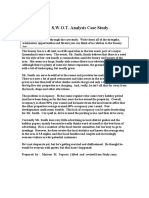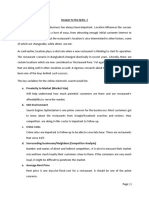0 ratings0% found this document useful (0 votes)
11 viewsHervas Mace 421 1st Exam
Hervas Mace 421 1st Exam
Uploaded by
ClarizzaCopyright:
© All Rights Reserved
Available Formats
Download as PDF, TXT or read online from Scribd
Hervas Mace 421 1st Exam
Hervas Mace 421 1st Exam
Uploaded by
Clarizza0 ratings0% found this document useful (0 votes)
11 views5 pagesCopyright
© © All Rights Reserved
Available Formats
PDF, TXT or read online from Scribd
Share this document
Did you find this document useful?
Is this content inappropriate?
Copyright:
© All Rights Reserved
Available Formats
Download as PDF, TXT or read online from Scribd
Download as pdf or txt
0 ratings0% found this document useful (0 votes)
11 views5 pagesHervas Mace 421 1st Exam
Hervas Mace 421 1st Exam
Uploaded by
ClarizzaCopyright:
© All Rights Reserved
Available Formats
Download as PDF, TXT or read online from Scribd
Download as pdf or txt
You are on page 1of 5
Name: Clarizza Joyce N.
Hervas BSMA-4 Code: 0567
Course/Subject: MACE 421 – Management Reporting
MACE 421 (1st Exam)
CASE I. S.W.O.T. Analysis Case Study
Strengths Weaknesses
Located in a high-traffic holiday There is no television, and there
resort town with easy access to is no Internet/Wi-Fi.
the beach and other major Tenancy rate is low.
attractions Grounds that are bare and
Very decent restaurants and unpleasant
takeaways are close by. Did not even try to sell right
Price is really affordable, only away since some people will
half the price of similar come in, have a look, and then
competitors. go.
Bedrooms that are large There is no restaurant service
(capable to accommodate on the site.
family) Typically, the motel's name isn't
Sites that are both large and particularly appealing.
open Only local advertising and
A large number of rooms are insufficient advertising
offered. There is no strong bond
Breakfast is served at a between the proprietor and the
reasonable price on a clean, local tourism committee.
well-kept grounds. A low rate can convey the
Have a great relationship with impression of poor quality.
some of our most loyal
customers.
Opportunities Threats
Make the ground location more Failure is a possibility if the
interesting by improving it. number of guests will not
Set up the television. increase.
Make the necessary internet There is a similar product on the
connections market with a lower price and
Outdoor amenities include a better facilities.
BBQ and picnic area, a Economic downturns may have
children's swimming pool, and a an impact on holiday spending.
mini golf course (if it not too Increase the rates for specific
costly). rooms.
Increase the amount of
advertising that is done
Increase the charges that are
paid
Collaborate with other
attractions, restaurants, and
other businesses (charge-back
facilities with nearby
restaurants, for example)
II. BALANCED SCORECARD
1. Enumerate and discuss the ways creating a Balanced Scorecard (BS) would
contribute to the organization.
A balanced scorecard is a performance indicator used to detect, improve, and
control an organization's numerous operations and outcomes. It is used to assess
learning and growth, business operations, customers, and finances. To implement a
balanced scorecard strategy, the company must first identify its main strategic
variables. Following that, each is linked to the relevant delivery variables and, last, to
measurement criteria. The performance management system is then built on top of
these.
Creating a Balanced Scorecard (BS) have great contributions to the
organization. It helps in the communication of the strategy to all members of the
organization by converting the strategy into a logical and linked set of operational
targets that are both understandable and measurable. The balanced scorecard is also
a tool that helps businesses analyze their customers' demands and value. In addition,
it aids the organization in focusing on strategic results and strategy, as well as ensuring
that strategic goals are linked to specific targets and the annual budget. Moreover, it
ensures that the vision, strategy, processes, projects, and people are all in sync. As a
result, business unit plans help to clarify, communicate, and cascade strategy.
Furthermore, it instills in employees a sense of responsibility and buy-in to change.
The organization's initiatives have been reprioritized, and everyone's responsibilities
have been explained. And it aids in the identification of essential performance
indicators and strategic goals. These are created and interconnected at every level,
guaranteeing that they are all connected. The balanced scorecard aids in assessing
the success of a strategy. There is a high level of stakeholder participation, which
increases commitment to implementing the strategy and can be used by any size
organization. That’s why, a balanced scorecard is essential to the organization since
it is one of the ways in reaching the organization’s goals and stated above are just
some of the contributions in creating a balanced scorecard in the organization.
In conclusion, the balanced scorecard is a management method that focuses
and prioritizes managerial energy in order to achieve both short- and long-term
corporate goals, as well as providing early warning signs for course correction. This
method has a lot of potential advantages. When done successfully, it relies on widely
scattered knowledge and combines it to arrive at a plan that maximizes the use of all
of the organization's assets: physical, human, and intangible. Although the attraction
of a quick fix is strong, bringing together current knowledge and creating new
knowledge where appropriate takes time.
You might also like
- Swot Analysis Case Study 2Document3 pagesSwot Analysis Case Study 2Rakib Rahman100% (2)
- Swot Analysis Snoozy InnDocument6 pagesSwot Analysis Snoozy InnIssa Chavez33% (3)
- Swot Analysis SalonDocument3 pagesSwot Analysis SalonJandro KareemNo ratings yet
- Hotel Revenue Management: The Post-Pandemic Evolution to Revenue StrategyFrom EverandHotel Revenue Management: The Post-Pandemic Evolution to Revenue StrategyNo ratings yet
- Opentable Group5Document18 pagesOpentable Group5CornCookies100% (1)
- Cost-Volume Profit AnalysisDocument26 pagesCost-Volume Profit AnalysisClarizza20% (5)
- Chapter 4Document79 pagesChapter 4Clarizza0% (1)
- Wedding Checklist For Telugu BridesDocument3 pagesWedding Checklist For Telugu BridesSumalakshya TatabhatlaNo ratings yet
- Bottle Grounds-4ps, SWOT, Market SegmentationDocument12 pagesBottle Grounds-4ps, SWOT, Market SegmentationMark XiarwilleNo ratings yet
- Marketing Study in R & F PENSION HOUSE 2Document16 pagesMarketing Study in R & F PENSION HOUSE 2Engel AlardeNo ratings yet
- Mkt470.Midterm - Saikh Mohammad Asifur Rahman. 1420309030pdfDocument10 pagesMkt470.Midterm - Saikh Mohammad Asifur Rahman. 1420309030pdfSadia Mehzabeen SharnaNo ratings yet
- Topic 10-Globalization-ScmDocument4 pagesTopic 10-Globalization-Scmsanchezchelly021No ratings yet
- Services Marketing Project ReportDocument9 pagesServices Marketing Project ReportramzanrazzaqNo ratings yet
- Nizamri - Ehsan PDDocument12 pagesNizamri - Ehsan PDNizamriNo ratings yet
- Internal and External Industry Analysis - SWOTDocument6 pagesInternal and External Industry Analysis - SWOTThierry ProsperNo ratings yet
- Front Office Associate - Dr. RaviDocument36 pagesFront Office Associate - Dr. Raviprashanth.nagarathnamNo ratings yet
- Module 5 Week 1-2Document12 pagesModule 5 Week 1-2lei melendrezNo ratings yet
- BSBMKG508Document17 pagesBSBMKG508yaya100% (1)
- PresentaionDocument20 pagesPresentaionqamerwajidNo ratings yet
- End-to-End Ecosystem Multi-Unit PDFDocument10 pagesEnd-to-End Ecosystem Multi-Unit PDFAbu IshaqNo ratings yet
- Library Work - Position Paper WritingDocument6 pagesLibrary Work - Position Paper Writingsamanthashaine.patindol.23No ratings yet
- Campaign On Red Nose Day. Case StudtyDocument20 pagesCampaign On Red Nose Day. Case StudtyplukchristianmoscaNo ratings yet
- SWOTT Hidden SpringsDocument7 pagesSWOTT Hidden SpringsrokinrossyNo ratings yet
- Sugar Bowl Case ReportDocument2 pagesSugar Bowl Case ReportRuben F. Zh100% (1)
- Revenue Management AcitivitiesDocument8 pagesRevenue Management AcitivitiesMike AntonioNo ratings yet
- The Hospitality IndustryDocument36 pagesThe Hospitality Industrymisilamani100% (1)
- QSM PrelimDocument10 pagesQSM PrelimAjiezhel NatividadNo ratings yet
- Digital Marketing Communication Plan - NewDocument18 pagesDigital Marketing Communication Plan - NewJustineNo ratings yet
- Event Planner Marketing PlanDocument18 pagesEvent Planner Marketing PlanFadhullah Dahlan Ibrahim83% (12)
- EVENTS (LIWAGON) OldDocument61 pagesEVENTS (LIWAGON) OldMiyuki TakaraNo ratings yet
- Universe Express Event Organization PlanningDocument16 pagesUniverse Express Event Organization PlanningRosalie PunlaNo ratings yet
- Chapter 3Document17 pagesChapter 3Madan maduNo ratings yet
- Fo Worksheets 8 SegmentsDocument12 pagesFo Worksheets 8 SegmentsJustin PerezNo ratings yet
- Sustainable Tourism Good Practice Guide For HotelsDocument6 pagesSustainable Tourism Good Practice Guide For HotelsGold TiongcoNo ratings yet
- Major Public Relations ActivitiesDocument14 pagesMajor Public Relations ActivitiesGirlie CaguioaNo ratings yet
- A Practical Guide To Pricing: E-BooksDocument23 pagesA Practical Guide To Pricing: E-BooksGuido SoldingerNo ratings yet
- SimonKucher Ebook A Practical Guide To PricingDocument23 pagesSimonKucher Ebook A Practical Guide To PricingHari Krishnan100% (1)
- Efas Sfas Tow IfasDocument5 pagesEfas Sfas Tow IfasFatima EhsanNo ratings yet
- Part One Business Marketing 1Document10 pagesPart One Business Marketing 1Herzyl Sunshine HinagpisanNo ratings yet
- Swot AnalysisDocument2 pagesSwot Analysismarichu apiladoNo ratings yet
- 6 Innovative Hotel FoodDocument5 pages6 Innovative Hotel FoodAhmed KamalNo ratings yet
- Developing Pricing Strategies For Direct MarketsDocument6 pagesDeveloping Pricing Strategies For Direct MarketszabeehNo ratings yet
- Internship - Assignment 1Document7 pagesInternship - Assignment 1anugill34567No ratings yet
- IMC ToolsDocument1 pageIMC ToolsMBA QT 2021No ratings yet
- Outsourcing Services in Europe - The Way Forward - General SeptDocument37 pagesOutsourcing Services in Europe - The Way Forward - General SeptjohnNo ratings yet
- Google Ads Google Ads Will Help in Lead Generation and Brand BuildingDocument4 pagesGoogle Ads Google Ads Will Help in Lead Generation and Brand BuildingSpandan GhoshNo ratings yet
- Prestwood & Razon EntrepDocument8 pagesPrestwood & Razon EntrepTey ParasNo ratings yet
- Session 16 Pricing of ServicesDocument30 pagesSession 16 Pricing of ServicesSakshi ShahNo ratings yet
- Assignment 2 Group 4BDocument5 pagesAssignment 2 Group 4BAnonymous zFnxvVrxNo ratings yet
- NguyenNgocAnh ASM3 MKT20032Document11 pagesNguyenNgocAnh ASM3 MKT20032doducha2211No ratings yet
- Thesis About Catering ServicesDocument7 pagesThesis About Catering Serviceswgsbsjxff100% (3)
- Cabo San Viejo: Prepared By: Ritu Shukla Lokesh Luhana Chandra Prakash Komal Gupta Arpit JangirDocument21 pagesCabo San Viejo: Prepared By: Ritu Shukla Lokesh Luhana Chandra Prakash Komal Gupta Arpit JangirLokesh_1988100% (1)
- Sales Activity Weekly Action PlanDocument2 pagesSales Activity Weekly Action Planዝምታ ተሻለNo ratings yet
- Events Planning Business: 1. Business Overview My Business (Value) PropositionDocument14 pagesEvents Planning Business: 1. Business Overview My Business (Value) Propositionwerewolf2010No ratings yet
- SWISS RESORT (Internet Mktg. Plan) - AngelDocument18 pagesSWISS RESORT (Internet Mktg. Plan) - AngelChaidine Abacaro100% (1)
- Loch Logan Potential Marketing PlanDocument26 pagesLoch Logan Potential Marketing PlankgwantibilankuluNo ratings yet
- Toast VFDocument23 pagesToast VFluca.doyleNo ratings yet
- Manage Customers For Profits (Not Just Sales)Document10 pagesManage Customers For Profits (Not Just Sales)furong.hsuNo ratings yet
- Rest Quiz1 SlidesDocument94 pagesRest Quiz1 SlidesDaniyal NasirNo ratings yet
- Optimizing Spending On ServicesDocument13 pagesOptimizing Spending On ServicesBerlin PacificNo ratings yet
- Club Med A SumeetDocument2 pagesClub Med A SumeetsumeetkantkaulNo ratings yet
- THE INVISIBLE ECONOMY OF CONSUMER ENGAGEMENT: Uncovering, Defining and Optimizing the Ocean of Trade Promotion and Channel Incentives Money That Drives Consumer EngagementFrom EverandTHE INVISIBLE ECONOMY OF CONSUMER ENGAGEMENT: Uncovering, Defining and Optimizing the Ocean of Trade Promotion and Channel Incentives Money That Drives Consumer EngagementNo ratings yet
- Feasibility Study PDFDocument13 pagesFeasibility Study PDFClarizzaNo ratings yet
- Hervas - Uloa Let's AnalyzeDocument2 pagesHervas - Uloa Let's AnalyzeClarizzaNo ratings yet
- Introduction To Management AccountingDocument30 pagesIntroduction To Management AccountingClarizzaNo ratings yet
- QUIZDocument30 pagesQUIZClarizza0% (1)
- Hervas - Ulob in A NutshellDocument2 pagesHervas - Ulob in A NutshellClarizzaNo ratings yet
- Balanced ScorecardDocument18 pagesBalanced ScorecardClarizzaNo ratings yet
- Management ConsultancyDocument29 pagesManagement ConsultancyClarizzaNo ratings yet
- Chapter 4 Quiz CBMDocument1 pageChapter 4 Quiz CBMClarizzaNo ratings yet
- Poem Reflection of RizalDocument2 pagesPoem Reflection of RizalClarizzaNo ratings yet
- Areas of MAS PDFDocument4 pagesAreas of MAS PDFClarizzaNo ratings yet
- Chapter 3 Quiz CBMDocument2 pagesChapter 3 Quiz CBMClarizzaNo ratings yet
- COVID-19 Assistance To Restart Enterprises (CARES) Program: Loan ApplicationDocument2 pagesCOVID-19 Assistance To Restart Enterprises (CARES) Program: Loan ApplicationClarizzaNo ratings yet
- Music Source Inc. (Exp. Cycle 2)Document16 pagesMusic Source Inc. (Exp. Cycle 2)ClarizzaNo ratings yet
- BMCM2713 Rev Question Chap 1Document5 pagesBMCM2713 Rev Question Chap 1gedepotNo ratings yet
- Cargo Control Supervisor Resume SampleDocument1 pageCargo Control Supervisor Resume Sampleresume7.com100% (1)
- Unit 5 Financial AdministrationDocument19 pagesUnit 5 Financial AdministrationSharmila ShankarNo ratings yet
- Beauty Salon Proposal For PsalmistDocument16 pagesBeauty Salon Proposal For PsalmistAdasi JobNo ratings yet
- Dpns On Ceramics and Ceramic ProductsDocument2 pagesDpns On Ceramics and Ceramic Productszhang sariNo ratings yet
- Honeywel S4560Document16 pagesHoneywel S4560Carlos BrancoNo ratings yet
- Hotel Sarina & Hotel Regency MainDocument49 pagesHotel Sarina & Hotel Regency MainGalib KhanNo ratings yet
- Huawei Insight of LTEDocument26 pagesHuawei Insight of LTEPunky Hero100% (2)
- Activity 2: Laplace and Inverse Laplace Transform Using MatlabDocument4 pagesActivity 2: Laplace and Inverse Laplace Transform Using MatlabJulie Anne FelipeNo ratings yet
- 200 Pleasurable ActivitiesDocument5 pages200 Pleasurable ActivitiesMirjana StevanovicNo ratings yet
- KV-N60AR DatasheetDocument4 pagesKV-N60AR Datasheetasrulnizam matnorNo ratings yet
- Followers Can Be Classified Based On - Type of Surface Contact Between Cam and Follower - Type of Follower Motion - Line of Motion of FollowersDocument25 pagesFollowers Can Be Classified Based On - Type of Surface Contact Between Cam and Follower - Type of Follower Motion - Line of Motion of FollowersN NandiniNo ratings yet
- Plaxis: CONNECT Edition V21.00Document26 pagesPlaxis: CONNECT Edition V21.00Hasnat Qureshi100% (1)
- ARM Compiler User Guide 100748 0614 00 enDocument253 pagesARM Compiler User Guide 100748 0614 00 enab12e58No ratings yet
- Rongpur Foundary Limited: ContentsDocument18 pagesRongpur Foundary Limited: ContentsRazzak RazzNo ratings yet
- I Semester: 15Pd01 Computational Mathematics 2 2 0 3Document11 pagesI Semester: 15Pd01 Computational Mathematics 2 2 0 3Subash VeluNo ratings yet
- C Programming LabDocument13 pagesC Programming LabGanesh KumarNo ratings yet
- A Liquid Delivery SystemDocument3 pagesA Liquid Delivery SystemEhtisham ZiaNo ratings yet
- 15scatvw CatalogDocument80 pages15scatvw CatalogemilioscherrerNo ratings yet
- 166 194 1 PBDocument5 pages166 194 1 PBnovitalumintusariNo ratings yet
- Concept Strengthening Sheet CSS 05 Based On AIATS 05 RM PhysicsDocument3 pagesConcept Strengthening Sheet CSS 05 Based On AIATS 05 RM Physicspratzchoubey111No ratings yet
- Factura NAPOLES 01-05-22Document35 pagesFactura NAPOLES 01-05-22Monica Carolina RIOS GOMEZNo ratings yet
- RFBT - Q&A Pt.2Document5 pagesRFBT - Q&A Pt.2John Mahatma Agripa100% (1)
- Leveling Height of Colimation MethodDocument7 pagesLeveling Height of Colimation Methodjoenew2000No ratings yet
- 1-Day Blue Ocean Strategy TrainingDocument6 pages1-Day Blue Ocean Strategy TrainingBee Teo100% (1)
- Handbook On Differentiated Instruction For Middle - (Learning Centers)Document4 pagesHandbook On Differentiated Instruction For Middle - (Learning Centers)YSNo ratings yet
- Are Edtech Valuations in A Bubble?: June 2021Document23 pagesAre Edtech Valuations in A Bubble?: June 2021S1626No ratings yet
- NDT Module 1Document23 pagesNDT Module 1Sajeesh Saji100% (1)
- Controlling Diabetes Thru SupplimentDocument4 pagesControlling Diabetes Thru SupplimentNeeru SudhirNo ratings yet








































































































